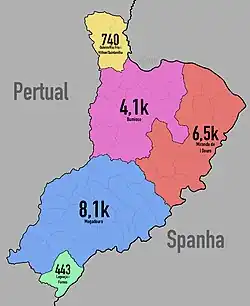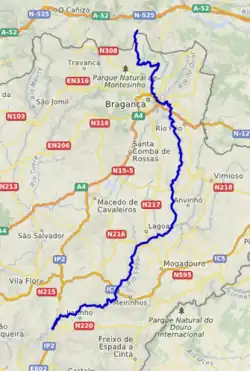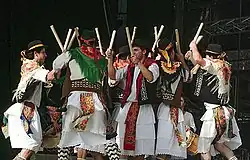Terra de Miranda
| Miranda Land(s) | |
.jpg) Miranda de l Douro | |
 Tierra de Miranda divided into official municipalities, with populations displayed. | |
| Country | |
| District | Bragança (Mirandese: Bergáncia) |
Terra(s) de Miranda (European Portuguese: [ˈtɛʁɐ(ʒ) ðɨ miˈɾɐ̃dɐ]; Mirandese: Tierra(s) de Miranda, Mirandese: [ˈtjerɐ(z̺) ðɨ miˈɾɐ̃dɐ]; lit. 'Land(s) of Miranda') is a cultural region in northeastern Portugal, centered around the city of Miranda de l Douro (Portuguese: Miranda do Douro) on the border with Spain, where Mirandese (rather than Portuguese) is commonly spoken.
Etymology
The etymology of the toponym Miranda is still debated, though it is a common place name across Portugal, Spain, and their former colonial empires. The Latin mirandus means "worthy of admiration" (whence the given name "Miranda"), and when used in a place name seems to indicate an area at or around a vantage point, such as a watchtower or a belvedere.
The use of tierra(s)/terra(s) serves to distinguish the wider cultural area from the smaller Miranda do Douro municipality.
Geography
Boundaries

Though it does not have any precisely agreed-upon boundaries, Tierra de Miranda, at its narrowest definition, consists of the municipality of Miranda de l Douro as well as neighboring parishes in the Bumioso (Portuguese: Vimioso) and Mogadouro municipalities where Mirandese dialects remain in common use. At its broadest, it may include most or all of the regions of Bragança District east of the Sabor River, including areas where Leonese dialects distinct from Mirandese are/were spoken (such as Deilão and Rio de Onor parishes). These regions were historically part of the Diocese of Astorga, and during the Reconquista were settled by speakers of Old Leonese (which eventually evolved into Mirandese and other Asturleonese dialects).
Culture

Among the best-known cultural features of the area are the Mirandese language, the Pauliteiros, the pagan rituals practiced from Christmas to Easter, the farandulo, and bagpipe music.